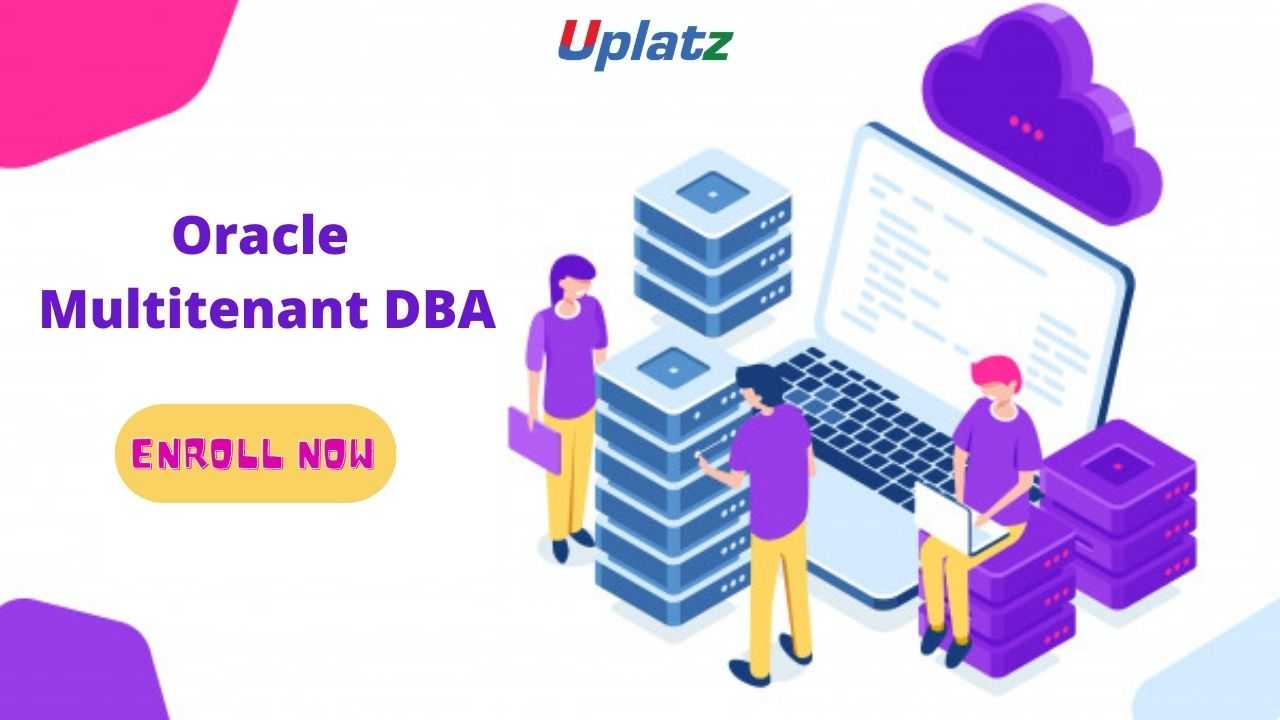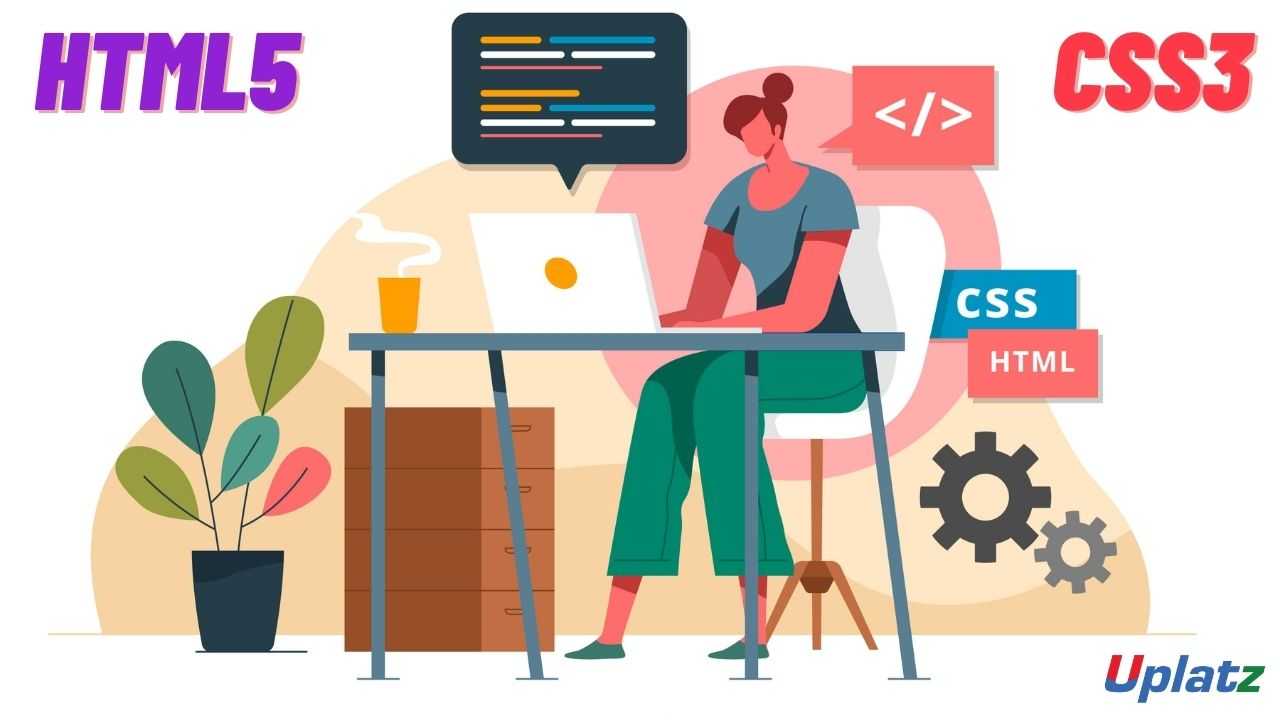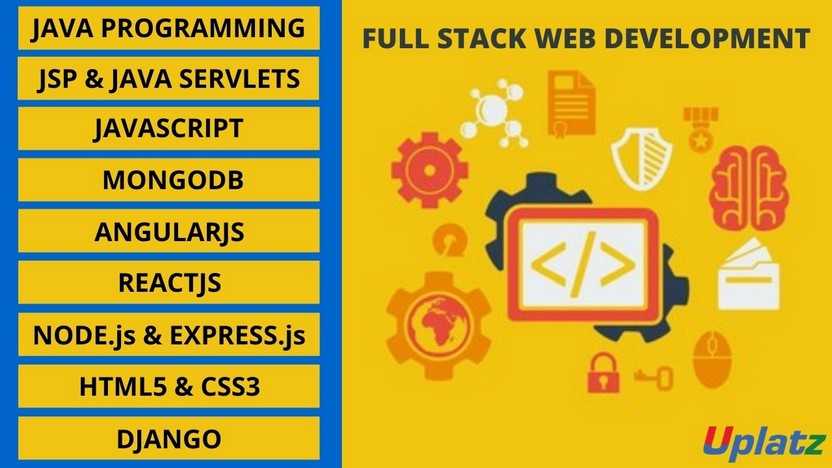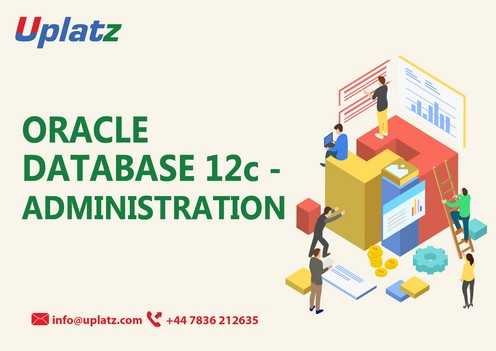Oracle Multitenant DBA
Learn how to create an Oracle multitenant capabilities. View Course Curriculum
Price Match Guarantee
Full Lifetime Access
Access on any Device
Technical Support
Secure Checkout
Course Completion Certificate
View Course Curriculum
Price Match Guarantee
Full Lifetime Access
Access on any Device
Technical Support
Secure Checkout
Course Completion Certificate
 42% Started a new career
BUY THIS COURSE (
42% Started a new career
BUY THIS COURSE (GBP 12 GBP 29 )-
 59% Got a pay increase and promotion
59% Got a pay increase and promotion
Students also bought -
-

- HTML5 and CSS3
- 15 Hours
- GBP 12
- 1333 Learners
-

- Bundle Course - Full Stack Web Development
- 200 Hours
- GBP 22
- 3788 Learners
-

- Oracle DBA
- 10 Hours
- GBP 12
- 478 Learners

Oracle Multitenant is a new option for Oracle database. It consists of a database and at least an instance. Oracle Multitenant enables an Oracle Database to function as a container database (CDB). All Oracle databases before Oracle Database 12c were non-CDBs. A CDB includes zero, one, or many customer-created pluggable databases (PDBs). It consolidates multiple pluggable databases (PDB), a portable collection of schemas, schema objects, and non-schema objects.
Oracle multitenant databases were developed to help companies take advantage of all the above technologies and cost savings. There are different methods of creating a pluggable database like (i) creating a PDB from the seed (ii) Cloning PDBs from local or remote PDBs including the refreshable PDBs (iii) Plugging in an Unplugged PDB (iv) Relocating a PDB and others.
Oracle Multitenant DBA course by Uplatz will take you all the way to create an Oracle multitenant capabilities. This is a good opportunity for the students to not only learn the concepts but also gain practical experiences in implementing them.
Course/Topic - Oracle Multitenant DBA - all lectures
-
In this tutorial you will provides an overview of the Oracle Database DBA from which you will get to know about the multitenant which represents one of the biggest architectural changes in the history of the Oracle database.
-
This video describes step by step process of setting up Oracle Linux 7.8 in Oracle VirtualBox. This is the exactly same method we use every-time when we have to create a VM and practice Oracle.
-
In this video we will show you how to properly install Oracle Database 19c software. Just to make the installation less complex and easy to understand we create simple sections.
-
This tutorial shows you how to create the Container Database (CDB) and non-container database with a typical configuration. You can also create a non-CDB either automatically or manually. Oracle suggest that you can use the automatic creation procedure outlined in creating a Database automatically.
-
In this video you will know to about CREATE PLUGGABLE DATABASE statement to create a new PDB by using the files of the PDB seed or an application PDB from the files of an application seed or the PDB seed.The statement copies these files to a new location and associates them with the new PDB. The following figure illustrates how this technique creates a new PDB in a CDB with the CDB root as the current container.
-
As an Oracle database administrator (DBA), you can expect to be involved in the following tasks such as Installing Oracle software, Creating Oracle databases, Performing upgrades of the database and software to new release levels, Starting and shutting down the database instance, Managing the storage structures of the database and many more.
-
In this video you will learn how to Creating a PDB by Cloning from Local and Remote PDBs and how to use them.
-
In this session, Create and define a destination for the new data files, plug the unplugged PDB into the CDB, and then copy the data files of the unplugged PDB. Use the data files of the unplugged PDB to plug the PDB into the CDB and copy the data files to a new location.
-
In this video, you need to convert a non-CDB database into a CDB pluggable database. This video describes methods that you can use to convert a non-CDB database into a CDB database.
-
To Connect to the local database to initiate the relocate. Check the local CDB is in local undo mode and archive log mode. Create a public database link in the local CDB, pointing to the remote CDB. Remember to remove this once the relocate is complete.
-
A Common user is a user which have the same username and password authentication across of PDBs of CDB. Common users and Local users: This concept came with Oracle Database 12c. Common Users.
-
A backup of the root container is a backup of the CDB, excluding any of the PDBs. Connect to RMAN using OS authentication and backup the root container using the command in this video.
-
Oracle Flashback Database gives a more efficient direct alternative to database point-in-time recovery. It is unlike the other flashback features in that it operates at a physical level. When you use Flashback Database, your current datafiles revert to their contents at a past time.
-
In this video, you can use PL/SQL package procedures to administer Oracle Resource Manager (Resource Manager) to allocate resources to pluggable databases (PDBs) in a multitenant container database (CDB).
-
A PDB is a portable set of schemas, schema objects, and non-schema objects that appear to an Oracle Net client as a non-CDB. A multitenant container database (CDB) is an Oracle database that includes zero, one, or many user-created pluggable databases (PDBs).
-
In this last video You can learn the administer application containers, including application roots and application PDBs. You can also administer the applications installed in application containers.
• End-to-end knowledge of Oracle Multitenant Database Administration
• Become a top Oracle DBA
• Learn Oracle Multitenant Database Administration & Management
• Manage Oracle Database Multitenant Architecture
• Overview of Oracle Multitenant DBA
• Installing Oracle Linux 7.8 in Oracle Virtual Box
• Installing Oracle Database 19c Software
• Creating CDB and non-CDB databases
• Creating PDBs from the Seed
• Performing Basic CDB Administration Tasks
• Creating a PDB by Cloning from Local and Remote PDBs
• Creating PDB by Plugging in an Unplugged PDB
• Creating a PDB from non-CDB
• Creating a PDB by Relocating a PDB
• Managing Common and Local Users
• Backup and Recovery in CDB and PDBs
• Flashback and Point-in-time Recovery
• Using Resource Manager with CDB and PDBs
• Using Data Pump Utility with PDBs
• Managing Applications and Application Containers
Oracle Multitenant DBA - Course Syllabus
1. Overview of Oracle Multitenant DBA
2. Installing Oracle Linux 7.8 in Oracle Virtual Box
3. Installing Oracle Database 19c Software
4. Creating CDB and non-CDB databases
5. Creating PDBs from the Seed
6. Performing Basic CDB Administration Tasks
7. Creating a PDB by Cloning from Local and Remote PDBs
8. Creating PDB by Plugging in an Unplugged PDB
9. Creating a PDB from non-CDB
10. Creating a PDB by Relocating a PDB
11. Managing Common and Local Users
12. Backup and Recovery in CDB and PDBs
13. Flashback and Point-in-time Recovery
14. Using Resource Manager with CDB and PDBs
15. Using Data Pump Utility with PDBs
16. Managing Applications and Application Containers
The Oracle Multitenant DBA Certification ensures you know planning, production and measurement techniques needed to stand out from the competition.
Multi-tenancy means that a single instance of the software and its supporting infrastructure serves multiple customers. Each customer shares the software application and also shares a single database. Each tenant's data is isolated and remains invisible to other tenants.
A pluggable database (PDB) is a portable collection of schemas, schema objects, and non schema objects that appears to an Oracle Net client as a non-CDB. PDBs can be plugged into CDBs. A CDB can contain multiple PDBs. Each PDB appears on the network as a separate database.
A multi-instance architecture provides each customer with their own unique database. Rather than using a large centralized database, instances are deployed on a per-customer basis, allowing the multi-instance cloud to scale horizontally and infinitely.
The Oracle Certified Associate (OCA) credential is the first step toward achieving an Oracle Certified Professional certification. The OCA credential ensures a candidate is equipped with fundamental skills, providing a strong foundation for supporting Oracle products.
Oracle's Java Certification has a tough passing percentage, close to 65% for both OCAJP (the Oracle Certified Associate Java Programmer) and OCPJP (the Oracle Certified Professional Java Programmer). You need in-depth knowledge of the Java language and API to succeed in the exam.
Database administrator (DBA): Responsible for installing, configuring and maintaining a database management system (DBMS). Often tied to a specific platform such as Oracle, MySQL, DB2 or SQL Server.
Uplatz online training guarantees the participants to successfully go through the Oracle Multitenant DBA Certification provided by Uplatz. Uplatz provides appropriate teaching and expertise training to equip the participants for implementing the learnt concepts in an organization.
Course Completion Certificate will be awarded by Uplatz upon successful completion of the Oracle Multitenant DBA online course.
The Oracle Multitenant DBA draws an average salary of $115,000 per year depending on their knowledge and hands-on experience.
A career on the same is always a very key role for any candidate who is really expert in Oracle database management system. Also, looking for some challenging role and job satisfaction will be a good career to choose.
You'll find Oracle DBAs in virtually any and all industries as generally, every business needs some form of database management. According to the National Bureau of Labor Statistics, the demand for Oracle database jobs is set to rise 11% through 2026.
Note that salaries are generally higher at large companies rather than small ones. Your salary will also differ based on the market you work in.
Oracle WebLogic Administrator.
Senior Oracle WebLogic Administrator.
Oracle Applications DBA.
WebLogic Administrator.
Q1. List four possible ways (direct or indirect) to execute an SQL query against an Oracle Database?
Ans.
- Using the SQL*Plus command-line tool. With this tool, you can directly execute SQL commands.
- Using a GUI (Graphical User Interface) tool like SQL Developer. You can directly execute SQL commands with such tools.
- Using Oracle Enterprise Manager. This is an indirect way of executing an SQL query. When you perform certain operations with Oracle Enterprise Manager, they are converted to SQL queries implicitly and these SQL queries are executed against the database.
- Writing your own program. This is not a conventional way of executing your queries but actually, it is widely used. Any web or windows program that uses an Oracle database at the backend, executes SQL queries. These programs are written using a programming language like .NET or JAVA and they use a driver to connect to the database.
Q2. What Is SQL*Plus? How can one acquire it and what kind of operations can be performed with it?
Ans.
- SQL*Plus is a command-line tool developed by Oracle Corporation.
- It is freely distributed. It is shipped with Oracle client installations or Oracle database installations as a default. So, if Oracle client or Oracle database software is installed on a computer, you can find it under the “$ORACLE_HOME/bin/” directory. The name of the executable is “surplus” on Linux systems and “sqlplus.exe” on Microsoft Window Systems.
- You can connect to an Oracle database with it. Once connected, you can execute Oracle commands or SQL queries against the connected database. SQL*Plus has also its own commands for formatting the output so that you can display the results in a meat way.
Q3. Who is responsible to update the indexes?
Ans. Oracle automatically maintains and uses indexes and when any change is made in the table data Oracle automatically distributes it into relevant indexes.
Q4. In our organization, we’re using an Oracle database whose version is 11.2.0.4. Explain what each digit shows?
Ans. “11”: This first digit shows the major database version. Oracle usually publishes a major release once a 4 year. This digit is usually followed by a character describing the nature of the release. For example: 9i (internet), 10g (grid), 11g (grid), 12c (cloud).
“2”: This second digit shows the maintenance release number of the software. Oracle publishes the major release as maintenance release 1 and then usually publishes a second maintenance release during the lifetime of the software. New features are added to database Software with maintenance releases.
“o”: This third digit is Fusion Middleware Number. This will be o for database software.
“4”: This fourth digit is called Component-Specific Release Number and it shows the path set update that was applied to the software. Patch set updates are published 4 times a year by Oracle and as you apply them to your database software, this fourth digit advances.
Q5. In Oracle terminology, what is a Synonym?
Ans. A synonym is an identifier that can be used to reference another database object in a SQL statement. The types of database objects for which a synonym may be created are a table, view, sequence, or another synonym.
Q6. Your client said that he forgot the password for the “SYSTEM” user of his database and he no longer could connect. How would you recover this admin password?
Ans.
- If there are other users who have “DBA” privileges, you can connect with those users and change the password for the “SYSTEM” user. The users who have DBA privileges have the privilege to change any user’s password. This option is the easiest method but this may not be the case in all scenarios.
- If there are no other users with “DBA” privileges then the only way to connect to the database is to connect using operating system privileges. The Oracle software runs under a specific user at the operating system. This user is usually named “oracle”. Also, there needs to be a user group that the “oracle” user belongs to. This user group is usually named “dba”. The operating system users who belong to the “dba” group can connect to the database with “SYSDBA” privileges. So, you need to ask the system administrator to logon to a server as an “oracle” user or any user who belongs to this “dba” group. Once logged on to the operating system, you can connect to the database locally using operating system authentication with SYSDBA privileges. After connecting to the database, you can change the reset the password for this system user.
Q7. What is a password file and why is it needed?
Ans. Passwords for database users are stored in the data dictionary of the database. When a user wants to log into the database, the username and password provided by the user are checked against the values stored in the database.
If the username and password match, the user is granted access to the database. The data dictionary is part of the database and it will be accessible as long as the database is open. The passwords for administrators are stored in the dictionary as well.
When the database is closed, the data dictionary will be inaccessible. There needs to be a mechanism for administrators to login into the database even when it is closed because it is one of the administrator’s tasks to start up a down database. A password file is a separate operating system file that is stored on a disk outside of the database.
The username and password for the users who have SYSDBA or SYSOPER privileges are stored in it. Administrators who have those privileges are authenticated using this password file even when the database is down.
Q8. You want to find out how many users are defined in the password file and what privileges those users have. How would you accomplish this?
Ans. You need to query the “v$pwfile_users” view to get information about the existing users in the password file. Execute the SQL query below:
Sql>SELECT * FROM v$pwfile_users;
The query above will return four columns for each user in the password file. The column names are USERNAME, SYSDBA, SYSOPER, and SYSASM.
- The USERNAME column shows the username of the user in the password file.
- The SYSDBA column shows whether the user has SYSDBA privileges or not.
- The SYSOPER column shows whether the user has SYSOPER privileges or not.
- The SYSASM column shows whether the user has SYSASM privileges or not.
Q7. What would be the main responsibilities of an Oracle DBA in an organization?
Ans. The main duty of an Oracle DBA is to keep the Oracle Databases of the organization up and running. This may involve installing and configuring a database from scratch.
On a running system, the DBA will be the only privileged person who can shut down and startup the database.
The DBA will create new users and manage the privileges of each user.
He will take regular backups to ensure that data is safe. In case of a disaster, he will be responsible for restoring the database from backups. He will have to do monitor the space usage and do capacity planning for the database.
He will be responsible for enforcing security policies. He will have to monitor database activities. He will have to tune the database so that it works at an acceptable speed.
He is expected to follow the latest patches and apply them when applicable.
Q8. How does an Oracle DBA role differ from an Oracle Developer role in an organization? Are there any similarities between these two?
Ans. An Oracle developer is mainly responsible for developing backend applications. They do data modeling according to business rules. The design tables, create indexes and other types of constraints. They are expected to know SQL and PL/SQL. They develop procedures using this language.
However, the Oracle developers are not expected to administer the database software itself.
On the other side, an Oracle DBA’s main duty is to administer the database which involves tasks like doing maintenance to keep the databases up and running, taking backups, enforcing security policies, etc. DBAs are not primarily assigned to develop code.
DBAs are supposed to have a good knowledge of SQL and PL/SQL like a developer as these are also required for administering the database.
According to the structure of the organization, DBAs might also be assigned development tasks or at least assist the developers where necessary.
Q9. There are 10 identical servers and you want to install Oracle Database on each of them. What would you use to automate the installation process?
Ans. If you are going to do batch installations, it is best to do it with Oracle Universal Installer in silent mode. For single installations.it is best to start the installer in “interactive mode” and set installation options at each window.
However, in batch installations, this will take longer. You need to do the installations in “silent” mode with a “response file”. In a silent installation, you start the Oracle Universal Installer from a command prompt and specify the location of the “response file”.
The installation files and the response file can be shared among the servers via NFS so that you won’t have to copy the setup files to each server.
Q10. You want to create a response file to speed up the installation of databases. How would you prepare a response file?
Ans. A response file is a plain text file, where options to create a database are stored. It is possible to create it manually from scratch but that would take longer and would be erroneous.
Installation media comes with a template response file. It is rather easier to customize it manually. This file also contains notes about the parameters.
However, the easiest and most reliable way to create a response file is by using Oracle Universal Installer. If you start the installer in “record” mode, every option you choose at each step is automatically recorded in a response file in the correct format. After the installer completes in “record” mode, you’ll have a complete response file with all the options set in it.









